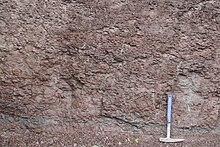
Back Rocas arcillosas Spanish Savikivimid Estonian Mudrock French Skała ilasta Polish Mudrock SIMPLE Глинисті породи Ukrainian


Mudrocks are a class of fine-grained siliciclastic sedimentary rocks. The varying types of mudrocks include siltstone, claystone, mudstone and shale. Most of the particles of which the stone is composed are less than 1⁄16 mm (0.0625 mm; 0.00246 in) and are too small to study readily in the field. At first sight, the rock types appear quite similar; however, there are important differences in composition and nomenclature.
There has been a great deal of disagreement involving the classification of mudrocks. A few important hurdles to their classification include the following:
- Mudrocks are the least understood and among the most understudied sedimentary rocks to date.
- Studying mudrock constituents is difficult due to their diminutive size and susceptibility to weathering on outcrops.
- And most importantly, scientists accept more than one classification scheme.
Mudrocks make up 50% of the sedimentary rocks in the geologic record and are easily the most widespread deposits on Earth. Fine sediment is the most abundant product of erosion, and these sediments contribute to the overall omnipresence of mudrocks.[1] With increased pressure over time, the platey clay minerals may become aligned, with the appearance of parallel layering (fissility). This finely bedded material that splits readily into thin layers is called shale, as distinct from mudstone. The lack of fissility or layering in mudstone may be due either to the original texture or to the disruption of layering by burrowing organisms in the sediment prior to lithification.
From the beginning of civilization, when pottery and mudbricks were made by hand, to now, mudrocks have been important. The first book on mudrocks, Geologie des Argils by Millot, was not published until 1964; however, scientists, engineers, and oil producers have understood the significance of mudrocks since the discovery of the Burgess Shale and the relatedness of mudrocks and oil. Literature on this omnipresent rock-type has been increasing in recent years, and technology continues to allow for better analysis.
- ^ Boggs, S. (2005). Principles of Sedimentology and Stratigraphy (4th ed.). Upper Saddle River, N.J.: Prentice Hall. ISBN 0-13-099696-3.
© MMXXIII Rich X Search. We shall prevail. All rights reserved. Rich X Search